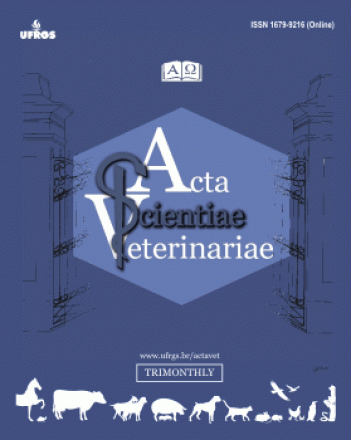Collaterals branches of the aortic arch and its main rami in nutria (Myocastor coypus)
Acta Scientiae Veterinariae
Collaterals branches of the aortic arch and its main rami in nutria (Myocastor coypus)
Autor Correspondente: Rui Campos | [email protected]
Palavras-chave: aortic arch, artery vascularization, rodentia
Resumos Cadastrados
Resumo Inglês:
Background: Nutria (Myocastor coypus), also known as Swamp Beaver, is a medium-sized semiaquatic rodent that belongs to
the Capromyidae family. Originally from the southernmost part of South America, the species is distributed in several parts
worldwide such as Europe and United States, where it has been used for commercial purposes due to the excellent quality of
its fur and meat. Information about the nutria morphology is rare. Only a few articles about its abdominal aorta branches can
be found, but nothing exists regarding its aortic arch. Consequently, other rodents such as chinchillas, agoutis, guinea pigs
capybaras, pacas and rats will be used in the discussion. Therefore, this study aims to obtain morphological information that
could justify such discussions in a functional point of view, and that could result in support for a better understanding of the
physiology of this animal.
Materials, Methods & Results: Thirty-two Myocastor coypus were used in the study, originated from a breeding facility in the
town of Caxias do Sul, RS and authorized by IBAMA. The animals were put to sleep by means of an anesthetic overdose
administrated intraperitoneally, and kept in formaldehyde for seven days to be subsequently dissected. After having their
arterial system flushed with saline solution, the aorta of thirty specimens received an injection containing latex 603 through
the left ventricle, for later observation of the arteries of the cranial mediastinal space and neck. Dental resin was injected in two
specimens, for subsequent manufacture of molds by means of maceration. Schematic drawings of all parts were made with the
help of a magnifying glass, for posterior composition of results. The brachiocephalic trunk and the subclavian artery arose in
sequence from the aortic arch of the nutria in 60% of the samples, whereas the brachiocephalic trunk, left common carotid
artery and left subclavian artery arose from the arch in 40% of the samples. The branching sequence of the collateral branches
of the subclavian arteries showed a great variation, presenting isolated vessels and forming trunks among the arteries identified
(according to the tables). The thoracic vertebral, vertebral, internal thoracic, dorsal scapular arteries and the superficial-deep
cervical trunk aroused medially from the right subclavian artery towards a lateral direction, as main collateral branches of
highest prevalence. On the other hand, the left subclavian artery also gave off the vertebral artery as its first vessel, followed by
the internal thoracic and thoracic vertebral arteries, and its last collateral branch was a common trunk between the dorsal
scapular artery and the superficial-deep cervical trunk.
Discussion: Other rodents in the study presented the same aortic arch sequence as observed in nutrias i.e., the brachiocephalic
trunk and the left subclavian artery. But the branches of these main vessels showed remarkable differences, with the formation
of several common trunks among the arteries. Additionally, the origin sequence of these vessels was different in the rodents
studied. Therefore, the aortic arch of nutrias has two model patterns for its branching. In 60% of the samples, the aortic arch
gives off the brachiocephalic trunk and the left subclavian artery as collateral branches. In 40% of the samples, however, the
branching sequence is composed of the brachiocephalic trunk, the common left carotid artery and the left subclavian artery.

